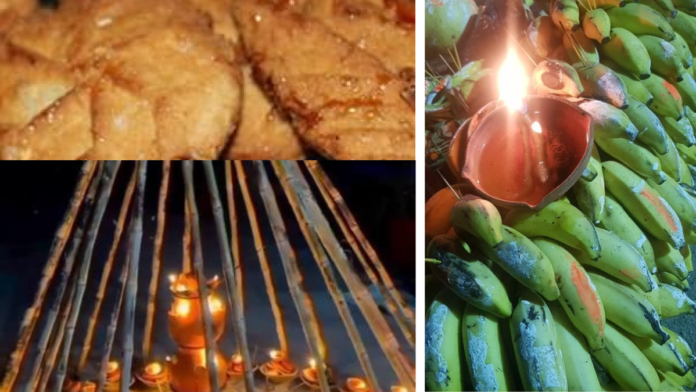Chhath Puja is a Hindu festival dedicated to the Surya Dev and his consort Usha. The festival involves various rituals and offerings, each with significant symbolism. Every item used in the puja holds deep spiritual meaning and cultural importance, connecting devotees to nature, well-being, and the Sun’s life-sustaining energy.
Here’s an overview of some key items used in Chhath Puja and their significance:
Daura and Baya (Bamboo Baskets and Trays)
These bamboo baskets are used to carry the offerings, Prasads or Ardhya items, including the fruits, Thekua, Rice balls, and coconut. Bamboo represents strength and resilience, and the handmade baskets promote eco-friendliness, as they decompose naturally and do not harm the environment.
The Soop (Winnowing Basket)
TheSoop is a traditional bamboo basket used to hold offerings like fruits, sweets, and grains. It symbolizes simplicity, humility, and the agricultural roots of the festival, as well as the respect for hard work and sustenance that nature provides. People have now started using gold, silver and brass soops also.
Diya (Earthen Lamps)
Earthen lamps lit during the puja represent light and energy, signifying the presence of the Surya Dev and the illumination of wisdom and virtue in life. The diya also symbolizes the removal of darkness and negative energies, as devotees pray for blessings and the well-being of the near and dear ones.
Thekua (Sweet Wheat Cake)
Thekua, a popular offering made from wheat flour, jaggery, and ghee, symbolizes purity and devotion. Wheat, a staple grain, represents sustenance and fertility, while jaggery signifies sweetness and prosperity. Thekua is an identity of Chhath and Bihar.
Gangajal (Water from the Ganges)
Water from the River Ganges or other holy rivers is used for purification. It is believed to cleanse the surroundings and the devotees, ensuring a sacred space for worship. Gangajal represents purity and divine connection to the holy river.
People go to rivers on many occasions to have a holy dip.
Mitti ka Chulha
The mitti ka chulha (clay stove) is a significant part of Chhath Puja, embodying the festival’s values of purity, simplicity, and respect for nature. During Chhath Puja, devotees use the clay stove to prepare offerings, or prasad, such as thekua, and kheer, which are central to the rituals.
Kele ka thamb (Small banana Plant)
The banana plant is believed to have a strong connection to Goddess Chhathi Maiya. The banana plant is known for its quick growth and high yield, symbolizing prosperity, fertility, and abundance. In Chhath Puja, placing the kela ka thamb signifies a wish for prosperity, health, and the flourishing of family and community.
Seasonal Fruits
Fruits like bananas, coconuts, and sugarcane are offered during Chhath Puja. These symbolize abundance, vitality, and the gratitude of devotees towards nature for providing food. Each fruit has its own significance; for instance, coconut represents fertility and purity, while bananas are a symbol of prosperity and well-being.
Sugarcane Stalks
Sugarcane stalks are essential items placed around the setup for the puja. They represent growth and sweetness in relationships and the support of family and community bonds. In addition, sugarcane is a hardy crop, reflecting resilience and strength. Sugarcane is also used as a cultural marker in Chhath Puja celebrations, symbolizing unity and continuity. Its presence in rituals serves to connect generations through a shared tradition.
Kheer Prasad
Offering kheer to Surya Dev and Chhathi Maiya expresses gratitude for life’s essentials nourishment, energy, and health. This prasad is part of a ritual that connects devotees to their environment and the divine, emphasizing a harmonious coexistence.
Arghya (Water Offering)
This offering is the main ritual of Chhath Puja, where devotees offer water to the Sun at Suryastaya (dawn) and Suryadaya(dusk). Arghya represents gratitude to the Sun for its life-giving energy and light, and for fulfilling the devotee’s wishes and providing health and prosperity.
Earthen Pots, Kalas (Matkas)
Filled with water, these pots are used in the ritual offerings. The pots symbolize Mother Earth and the balance of nature. The water represents life, and using it in Chhath Puja emphasizes the interconnectedness of all living beings.
Sand and Clay Idols of the Sun and Chhathi Maiya
Small idols of the Sun God and Chhathi Maiya, created from clay and sand, are placed on the ghats or riverside. These idols signify the close bond between devotees and the deities and underscore a humble connection to the Earth.
Sona Patta (Sacred Leaves)
Banana leaves, mango leaves, paan patta or other green leaves are used to decorate the offerings and the place of worship. They signify freshness, life, and fertility, and are a symbol of nature’s bounty. Their use emphasizes gratitude towards plants and trees.
Each item plays a role in enhancing the devotion, purity, and spiritual connection between the devotee, nature, and divine energies. Through these offerings, Chhath Puja beautifully exemplifies the harmony between humanity and nature.
